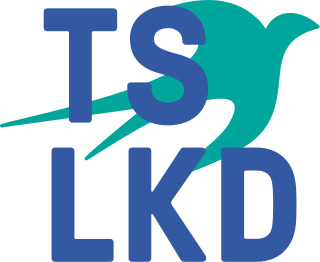Related Research Articles

Politics of Lithuania takes place in a framework of a unitary semi-presidential representative democratic republic, whereby the President of Lithuania is the head of state and the Prime Minister of Lithuania is the head of government, and of a multi-party system.

The Seimas of the Republic of Lithuania, or simply the Seimas, is the unicameral parliament of Lithuania. The Seimas constitutes the legislative branch of government in Lithuania, enacting laws and amendments to the Constitution, passing the budget, confirming the Prime Minister and the Government and controlling their activities.

Gediminas Vagnorius is a Lithuanian politician and signatory of the Act of the Re-Establishment of the State of Lithuania. He served as the Prime Minister of Lithuania, heading the government between 1991 and 1992, and again from 1996 until 1999.

The Homeland Union – Lithuanian Christian Democrats is a centre-right political party in Lithuania. It has 18,000 members and 50 of 141 seats in the Seimas.
Albertas Šimėnas was Prime Minister of Lithuania for 3 days, from 10 to 13 January 1991. He disappeared during the January Events and was replaced by Gediminas Vagnorius.

Laurynas Mindaugas Stankevičius was a Lithuanian economist and politician who served as the 7th Prime Minister of Lithuania from February to November 1996. He previously served as the Minister of Social Security and Labour from 1993 to 1994, and after being prime minister, was a member of the Seimas from 1996 to 1998, and later Minister of Health from 1998 to 1999. Formerly a member of the Communist Party of Lithuania, following independence he joined the newly formed Democratic Labour Party.

Government of the Republic of Lithuania is the cabinet of Lithuania, exercising executive power in the country. Among other responsibilities, it executes laws and resolutions of the parliament, the Seimas, and the decrees of the President, manages state property and, together with the President, executes the foreign policy of the country. The Government also has the right of legislative initiative, puts together the state budget and presents it to the Seimas for approval.

Parliamentary elections were held in Lithuania in two stages on 25 October and 15 November 1992. All 141 members of the Seimas, which replaced the Supreme Council, were elected; 70 based on proportional party lists and 71 in single member constituencies. Where no candidate gained more than 50% of the vote on 25 October, a run-off was held on 15 November. The first round of the elections were held simultaneously with a referendum on the adoption of a new constitution.

Parliamentary elections were held in Lithuania in two stages on 20 October and 10 November 1996. All 141 seats in the Seimas were up for election; 70 based on proportional party lists and 71 in single member constituencies. Where no candidate gained more than 50% of the vote on 20 October, a run-off was held on 10 November.
The Supreme Council – Restoration Seimas of the Republic of Lithuania, was the supreme governing body, elected in 1990. The first meeting was held on 10 March 1990, the last – 11 November 1992.

The Sixth Seimas of Lithuania was the first parliament (Seimas) elected in Lithuania after it restored independence on 11 March 1990. Elections took place on 25 October 1992, with the second round on 15 November. In a surprisingly decisive outcome, the elections were won by Democratic Labour Party of Lithuania (LDDP), with 73 seats. The result reflected widespread dissatisfaction with the economic situation and the policies of the ruling Sąjūdis political movement in the preceding Supreme Council of Lithuania.

Kirkilas Cabinet was the 14th cabinet of Lithuania since 1990. It consisted of the Prime Minister and 13 government ministers.

The Second Brazauskas Cabinet was the 13th cabinet of Lithuania since 1990. It consisted of the Prime Minister and 13 government ministers.

The First Kubilius Cabinet was the 10th cabinet of Lithuania since 1990. It consisted of the Prime Minister and 14 government ministers.

The First Paksas Cabinet was the 9th cabinet of Lithuania since 1990. It consisted of the Prime Minister and 14 government ministers.

The Second Vagnorius Cabinet was the 8th cabinet of Lithuania since 1990. It consisted of the Prime Minister and 17 government ministers.
Stankevičius Cabinet was the 7th cabinet of Lithuania since 1990. It consisted of the Prime Minister and 19 government ministers.

Abišala Cabinet was the 4th cabinet of Lithuania since 1990. It consisted of the Prime Minister and 18 government ministers.
Šimėnas Cabinet was the 2nd cabinet of Lithuania since the declaration of independence in 1990. It consisted of the Prime Minister and 17 government ministers.
Prunskienė Cabinet was the 1st cabinet of Lithuania since the declaration of independence in 1990. It consisted of the Prime Minister and 17 government ministers.
References
- 1 2 "Ankstesnės Vyriausybės. Po 1990 metų". Government of the Republic of Lithuania.
- 1 2 https://www.lrt.lt/naujienos/lietuvoje/2/1269888/kaip-1992-m-itvirtinta-siandienine-rinkimu-sistema-politiku-gincai-ir-rinkimu-data-lemusi-moneta
- ↑ "Vienuolika metų - dvylika premjerų". Delfi.lt. Retrieved 23 May 2016.